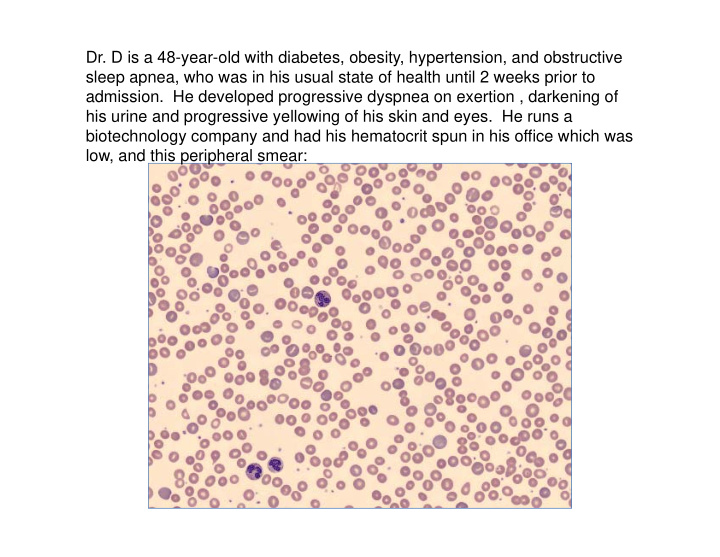



Dr. D is a 48-year-old with diabetes, obesity, hypertension, and obstructive sleep apnea, who was in his usual state of health until 2 weeks prior to admission. He developed progressive dyspnea on exertion , darkening of his urine and progressive yellowing of his skin and eyes. He runs a biotechnology company and had his hematocrit spun in his office which was low, and this peripheral smear:
What test(s) would you order next? A. PNH Screen B. Serum protein electrophoresis C. ADAMSTS level D. Direct antiglobulin test
He presented to an outside emergency room at Holy Cross on 4/27/12. There he had a hemoglobin of 6.6, was given 2 units of blood, treated with steroids. He was also found to have an anti-E antibody and warm agglutinins. He was treated with steroids with improvement initially and was discharged on 4/30/12. However, when he went home, he had worsening of his symptoms and was readmitted, received Solu-Medrol and 3 units of additional transfusion. He was transferred to Hopkins for further management, calling in the transfer himself as he was certain that Hopkins would have a better donor supply. Select the most true statement: A. JHU has unique access to a wider donor pool due to its extensive campus and number 2 status compared to regional hospitals B. The majority of his hemolysis is extravascular C. JHU will be able to provide crossmatch compatible blood D. Direct antiglobulin test will likely be positive for C3
A 66 ‐ year ‐ old woman presents with a hemolytic anemia and this blood smear. Select the true statement: A. She has IgG on the surface of her red cells B. This is a consequence of a delayed hemolytic transfusion reaction C. She has complement detectable on her red cells D. The blood bank has identified IgM on her red cells
Autoimmune Hemolytic Anemia: The View From The Blood Bank Karen E. King, M.D. Medical Director, HATS Associate Medical Director, Transfusion Medicine
Objectives • Review serologic findings for this patient • Discuss the serologic workup of WAIHA • Overview of transfusion issues related to WAIHA
Information from ARC
Information from ARC
ARC Recommendations
Serologic Evaluation
Indirect Antiglobulin Test
Direct Antiglobulin Test
Autoimmune Hemolytic Anemia
Drug Induced Immune Hemolytic Anemia
Causes of a Positive DAT • Autoimmune Hemolytic Anemia • Alloimmune disorders • Nonspecific adsorption of immunoglobulin from a drug • Passive antibody therapy • Idiopathic/unknown
Coombs Negative Warm AIHA • Approximately 10% of cases of warm AIHA have a negative DAT • More sensitive techniques may detect IgG in some cases • The significance of strength of DAT is uncertain
Reluctance to Transfuse Laboratory concerns: • Approximately 12% ‐ 40% of patients with autoantibodies will have underlying alloantibodies Clinical concerns: • RBCs for these patients will be crossmatch incompatible • We are taught to only transfuse crossmatch compatible RBCs
RBC ALLOANTIBODIES IN PATIENTS WITH WARM AUTOANTIBODIES #ANTIBODIES/ % OF SERA REFERENCE #SERA TESTED WITH ALLOABS • Morel 8/20 40 • Branch and Petz 5/14 36 • Wallhermfechtel et al 19/125 15 • Laine and Beattie 41/109 38 • James et al 13/41 32 • Issitt et al (alloadsorptions) 13/34 38 • Issitt et al (autoadsorptions) 5/41 12 • Leger and Garratty 105/263 40 _______ • TOTALS : 209/ 647 32% (Branch and Petz. Transfusion 1999;39:6-10.)
Transfusion 2002;42:1435-1441
Patients • 20 consecutive patients with warm autoantibodies, including: – 3 with primary AIHA, 6 with CLL, 4 with MDS • 8 of 20 had existing alloantibodies – 7 of 8 had multiple alloantibodies – Anti ‐ E identified in 6 of 8 patients • Complete phenotype determined in 12 cases
12 Patients with Complete Phenotypes 51 samples, 149 RBCs Total
8 Patients Required Adsorption Studies 39 samples, 144 RBCs Total
Phenotypically Matched Red Cells Issues: • Phenotype failures – Can use partial phenotyping to guide adsorption studies • Availability of phenotyped RBCs • Role for genotyping
Dr. C. Lockard Conley • Born May 14, 1915 • JHU, A.B. 1935 • Columbia, M.D. 1940 • JHH Director of Hematology, 1946 ‐ 1980
Autoimmune Hemolytic Anemia with Reticulocytopenia • Crosby and Rappaport, Blood 1956 • 34 patients with idiopathic AIHA • 15 patients with relative reticulocytopenia and hyperplastic erythroid marrows • 12 of 15 patients died • Poor prognostic indicator
Conley et al 5 patients with AIHA, reticulocytopenia and hyperplastic erythroid marrows were transferred from other hospitals with hcts of 8% ‐ 10% • Transfusions had been withheld due to incompatibility • Patients were transfused on arrival • Transfusions were felt to be life saving
Conley et al
Conley et al • Reticulocytopenia persisted for several days to more than 6 months • Patients required 2 to 84 units RBCs • AIHA with reticulocytopenia is a medical emergency JAMA 1980;244:1688-1690 NEJM 1982;306:281-286
Summary • Although hemolytic anemias are uncommon, AIHA is a common cause of hemolysis. • AIHA can occur without a + DAT; healthy people and patients without AIHA can have a + DAT. • The reticulocyte count is critical for diagnosis and management of AIHA. • The specific type of AIHA is important to permit the appropriate therapy and decrease the likelihood that transfusions will be required. • Transfusion can be lifesaving and must be used in patients with severe anemia, even if all blood is incompatible.
Recommend
More recommend